Top 7 IT Solutions Every Small Business Needs in 2025
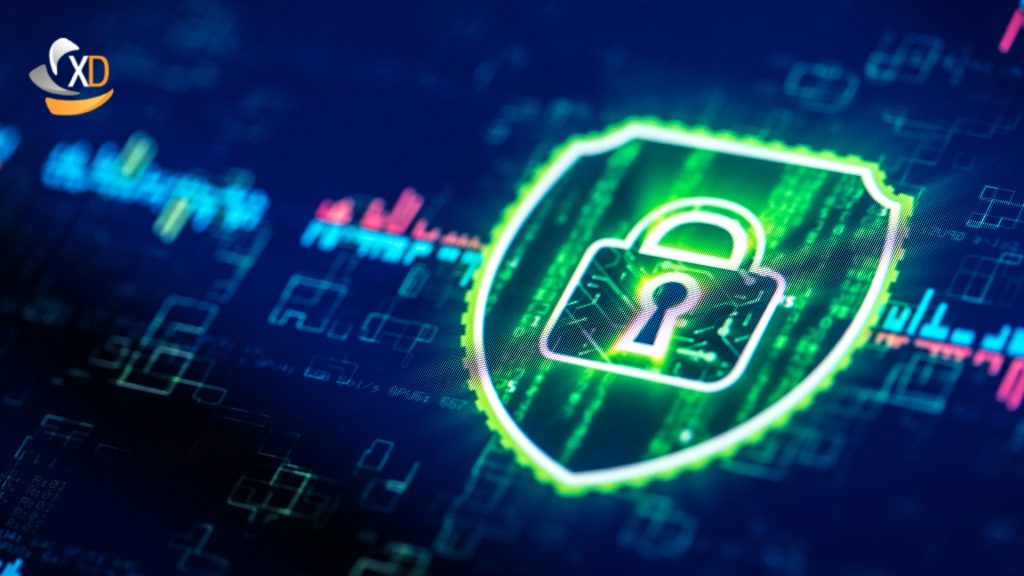
Running a small business in 2025 means you’re not just the CEO—you’re also the head of HR, sales, customer service, and IT security (even if you don’t want to be). That’s why searching for small business IT solutions near me has become so common. The good news? You don’t have to juggle it all. With the right IT services in place, you can protect your business, impress your clients, and sleep at night knowing your data is safe.
Here are the 7 must-have IT solutions every small business should consider this year (and how ExchangeDefender makes them simple).
1. Rock-Solid Email Security
Phishing, spoofing, spam, ransomware—it’s like a horror movie lineup, and email is still the #1 way attackers sneak in.
Solution: ExchangeDefender Email Security keeps your inbox clean and safe, making it one of the most trusted email security solutions for small business.
2. Compliance & Archiving
Whether you’re in healthcare, finance, or legal, compliance is no joke. Even if you’re not, having a secure record of all communications is just smart.
Solution: ExchangeDefender Archiving provides fully compliant, searchable records. Perfect for audits, peace of mind, and anyone Googling IT support for small business compliance.
3. Business Continuity
Imagine this: your internet goes down, but your email doesn’t. That’s true business continuity. No downtime, no missed deals.
Solution: With ExchangeDefender Inbox, your email keeps flowing, even if your servers or ISP fail.
4. Email Data Backups (Because Stuff Happens)
Hard drives fail. Employees delete things. Coffee spills. It happens.
Solution: Automated cloud email backups with ExchangeDefender Live Archive mean you’re never more than a few clicks away from recovery. That’s why so many people search for small business IT solutions near me—because accidents don’t wait for business hours.
5. Cloud Services That Actually Work
The cloud isn’t just hype—it’s how small businesses gain big-business power without the cost.
Solution: ExchangeDefender’s hosted email, cloud services, and managed IT give you enterprise-grade power without the enterprise headache.
6. Secure File Sharing & Encryption
Clients expect security when sharing sensitive data. Old-school email attachments don’t cut it anymore.
Solution: ExchangeDefender Secure File Sharing makes secure file sharing for small businesses simple, with encryption built right in.
7. Responsive IT Support
Even the best tech can break or confuse us. Having experts you can actually talk to (without 4-hour hold music) is priceless.
Solution: ExchangeDefender’s IT support team helps small businesses get fast, real solutions when they need them most.
Wrapping It Up
2025 is the year to stop seeing IT as “extra.” These seven solutions are your business insurance, your growth engine, and your peace of mind rolled into one.
And here’s the kicker: you don’t need seven different vendors. ExchangeDefender bundles everything together—making it the go-to for anyone searching IT solutions for small businesses near me.
👉 Ready to see how it works? Request a demo and let’s get your business future-proofed.
ExchangeDefender Rolls Out Advanced ‘Reject Policies’ for Safer Inboxes
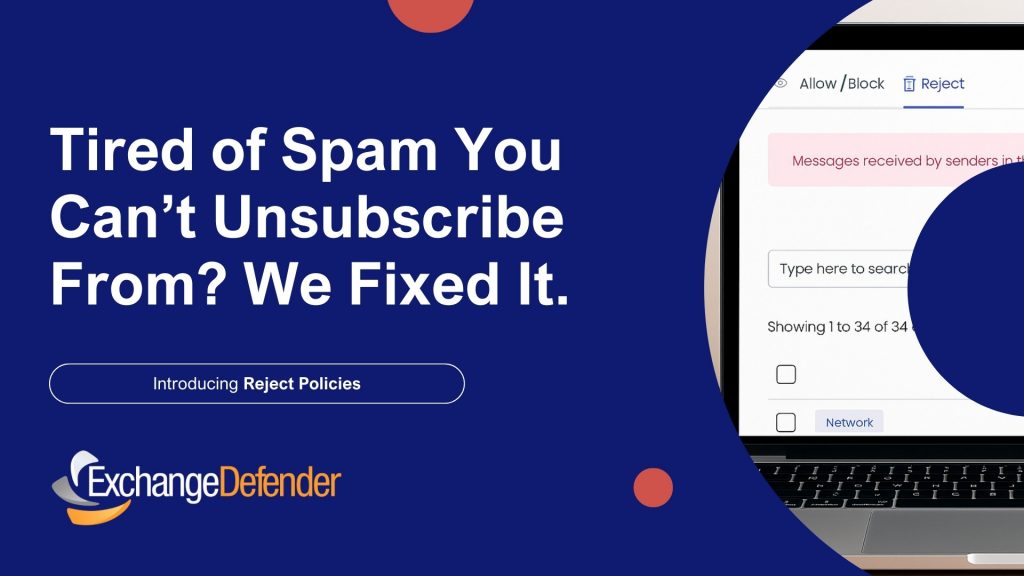
At ExchangeDefender we’ve always seen ourselves as the firewall that keeps unwanted email content entering or exiting our clients network. To keep compliance simple we never deleted emails – if the content was objectionable we would scan it, log it, and let org and user policies choose what happens to the message.
As the email world becomes more dangerous, with AI capable of conducting social engineering scams at scale, IT teams are looking for new policies that can handle it.
At ExchangeDefender we work closely with our partners around the world and this feature is courtesy of Tommy from Twisted Networx.
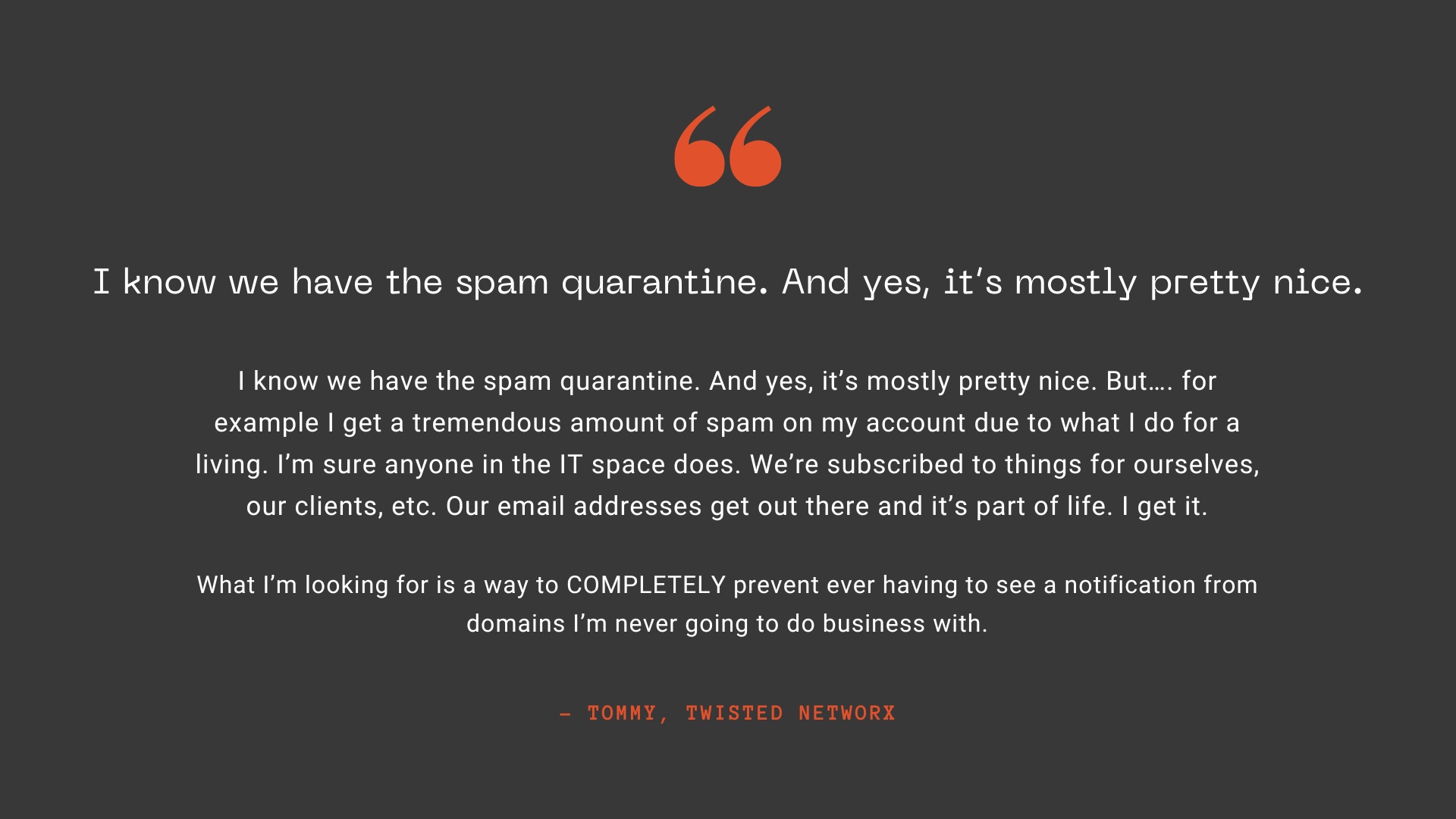
Tommy is hardly alone when it comes to this issue, some businesses pride themselves on the amount of money they spend on aggressive marketing via email. Ghost resubscribes, unsubscribe pages not working, confusing UI to trick you into buying or sharing info, and endless scams are just a part of business on the Internet these days. It’s something ExchangeDefender can help you fix.
We’re introducing Reject Policies.
If you’ve identified an organization you do not want to communicate with for any reason, or if you have a network you want to keep out, or if you just want a quieter quarantine: ExchangeDefender will now reject the email on your behalf and you will never have to see it again.
For compliance purposes we will of course log the rejection in the Domain Admin logging facility at https://admin.exchangedefender.com but the message meta and any data will be rejected at the edge of the ExchangeDefender network. This way you will still be able to troubleshoot mail flow and make adjustments as needed.
We’re building a more flexible, powerful ExchangeDefender to meet real-world business challenges—and your feedback plays a big part in that. If you’ve got ideas that could make your email experience more secure or productive, we’d love to hear them.
New features and updated policies are rolling out later this fall. Stay in the loop by visiting https://support.exchangedefender.com, checking out our blog, or following us on social media.
New in ExchangeDefender: Policy Import & Export
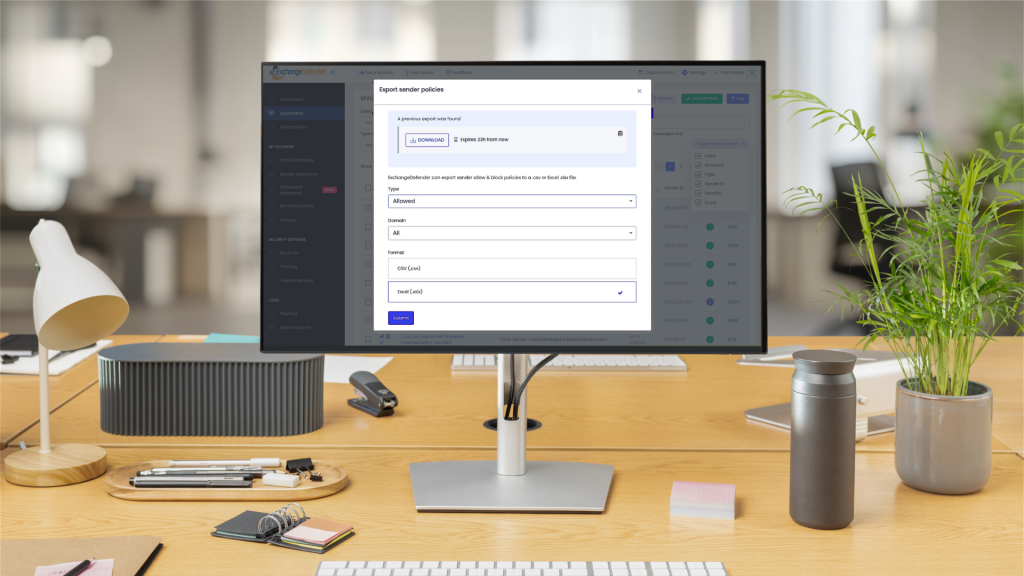
We’re excited to roll out a brand-new feature in ExchangeDefender that makes managing your Allow/Block lists faster, smarter, and more flexible: Policy Import & Export.
Your Allow/Block lists are one of the most powerful tools you have for controlling what lands in your inbox. With ExchangeDefender, you already get this control at three levels:
- Service Provider (big-picture defaults),
- Domain (organization-wide policies),
- User (personalized lists managed directly by each user).
ExchangeDefender makes them available on the Service Provider level, Domain level where they apply to every user in the organization, and User level where they are managed by the end user themselves by interacting with ExchangeDefender and their mail flow. Now you have the ability to export and import allow and black lists and manage your policies in bulk.
Why We Built This
Sure, partners have been asking for it—but that’s only part of the story. More and more, compliance teams, auditors, and SOC analysts want visibility into these policies. On top of that, IT admins are looking for better ways to integrate with SIEM, pull data into logs, or just do some long-overdue cleanup.
With Import & Export, you’ve got the flexibility to:
- Verify compliance with external audits.
- Sync policy data with your security tools.
- Clean up legacy lists in one shot.

How It Works
Head over to admin.exchangedefender.com.
- Users: Go to Trusted Senders.
- Domain Admins: Go to Allow / Block List.
You’ll see shiny new Import and Export buttons right at the top. Go to your Trusted Senders (as user) or Allow / Block List (as domain admin) and you will see an Import and Export button on the top left. The interface is simple and intuitive.

Exporting Policies
Need a backup or want to feed your SIEM? Click Export, pick your scope (allow or block), and choose your format (.csv or .xlsx).
Your download link appears instantly and sticks around for 24 hours. Want another copy? Just export again. Need to clean up old exports? One click deletes them. Easy.
Importing Policies
Time for some inbox spring-cleaning? That’s where Import shines.
When you upload, you’ll pick the domain and policy type (allow or block). At this point, you can:

- Start fresh by checking “Delete all existing policies” (highly recommended for cleanup).
- Or simply add to your existing lists.
From there, just upload your file and ExchangeDefender takes care of the rest—your policies are instantly updated.

Just import the file and the system will create all policies for you. Or you can type them in manually, which is great for everyone that wants to see visually what they are adding to the policy list and you don’t want to click a thousand times to do that.

This feature is all about giving you more control, efficiency, and peace of mind when it comes to managing your Allow/Block lists.
We hope this helps streamline your workflow and keeps your policies tidy. Got ideas for how we can make ExchangeDefender even better? We’d love to hear them—reach out on social media or at support.exchangedefender.com.
Tired of Vendor Headaches? Why MSPs Choose ExchangeDefender for Streamlined Support

Let’s be honest: managing vendors can feel like babysitting a circus. You’re juggling tickets, waiting on “escalations,” and explaining the same problem five different times—while your client is breathing down your neck asking, “Is it fixed yet?”
Sound familiar?
That’s exactly why so many MSPs are switching to ExchangeDefender—not just for rock-solid email security, but for support that actually supports you.
We Know What MSPs Need—Because We’ve Been There
ExchangeDefender was built with MSPs in mind from day one. That means:
- Fast, no-nonsense support
- Clear escalation paths
- A team that understands how you work
No more battling a clueless Tier 1 rep reading from a script. When you call or chat with us, you’re talking to someone who gets it—and gets moving.
Less Waiting, More Solving
Other vendors? You submit a ticket… it disappears into the void.
With ExchangeDefender:
- You get status updates, not silence
- You can chat with a real person, not a bot
- And when there’s an issue, we’re proactive, not reactive
Because your reputation’s on the line, and we treat it like our own.
Partner-First, Not Product-First
Most vendors focus on their platform. We focus on your business.
That means:
- White-labeled portals to make you look good
- Multi-tenant dashboards that don’t require a PhD to use
- Sales and marketing support to help you grow—not just survive
When we help you win, we win. Simple as that.
What Our Partners Say
“We cut down support tickets by over 50% after switching to ExchangeDefender.”
— A Real-Life, Much-Happier MSP
“I don’t have to explain the same issue 3 times. They just get it—and fix it.”
— Another Grateful IT Pro

The Bottom Line
If you’re tired of chasing down support teams and patching together vendor chaos, it might be time to try something built for you.
💡 With ExchangeDefender, you get:
- Powerful email security & continuity
- End-user tools that make support easier
- Real humans who know their stuff
Ready to ditch the vendor headaches?
👉 Start your free trial today.
Keep up with ExchangeDefender Changelog
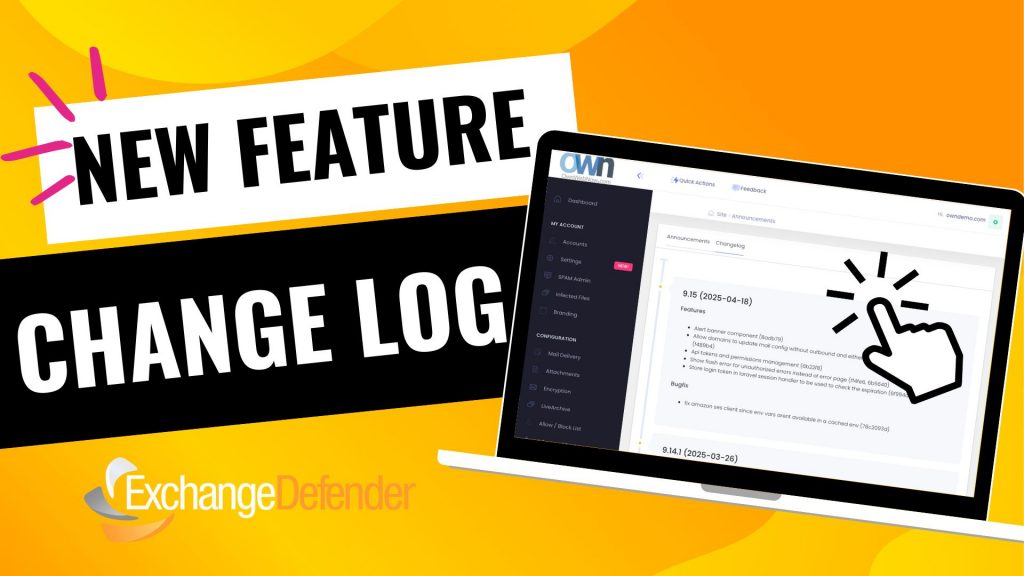
When we launched our new user interface infrastructure, we did so that we could run ExchangeDefender at the cutting edge. By bringing all of our apps under one umbrella, we can now monitor and address bugs and performance issues in real-time.
The pace of development has really picked up, and when things are constantly improving, it’s important to keep everyone informed when issues get addressed and bugs get fixed. At https://admin.exchangedefender.com, when you log in as a Domain Administrator, you will now see a new Announcements button on the bottom right.
You can view our announcements on this screen (same content that is available on the login screen) and you can click on the Changelog to see our recent changes. This way you can see what is being added and fixed, and we can track it back to the original issue report.
We owe a huge thank you to our partners and clients for feature suggestions and bug-fix help last month, we are working hard to keep the web apps at the top security and industry standards because this is how people exchange sensitive information and we take great effort to make that easier and more secure.
Texas Strengthens Cybersecurity with New State-Level Command Center

In February 2025, Texas Governor Greg Abbott announced the creation of the Texas Cyber Command, a state-level initiative headquartered in San Antonio.
This command center aims to enhance the state’s ability to anticipate, detect, and prevent cyberattacks, leveraging local expertise from institutions like The University of Texas at San Antonio. The Texas Cyber Command will collaborate with state universities, Regional Security Operation Centers, and various local and state agencies to create a unified defense against cyber threats.
Key objectives include promoting cybersecurity awareness, conducting simulation exercises, and providing forensic analysis for post-attack investigations. This development underscores the growing importance of state-level initiatives in safeguarding digital assets and infrastructure.
For a visual overview of the Texas Cyber Command, you can watch the following video:
ExchangeDefender WebUI: New Features & Enhancements! 🚀

As mentioned in the previous blog post, our new Web Services infrastructure is coming with a ton of new features, new UI, and new faster way of rolling things out that can help benefit & secure everyone.
In the previous post we discussed the scope of the update – rolling up over a decade and a half of legacy features, hacks, services, automations – all into a modern web services world where we can start rolling out features faster.
The biggest problem we are trying to solve now is how to quickly deploy efficient solutions. Most of the development time isn’t in actual coding or rollouts, most of the time is in design and confirming that users are able to quickly and effortlessly rely on them. Past service design was built over the years, as we helped our clients mitigate one security problem after another. Restructuring it will make things far smoother and easier to use.

Note the three single icons next to teach message checkbox. Tapping them on a touchscreen interface or with your mouse triggers the action to Release, Allow Sender, and Review. Icons aren’t very intuitive though – so we see people click on the checkbox and scroll all the way to the top to release a message.

Consider a new modern UI where icons become buttons. Would that change user behavior? Good news is that this will no longer be subject to opinion or guess but hard data as every element of our page will give us actual feedback about how the new feature is being used and how it’s performing:
By leveraging actual usage statistics and better insight on the backend, we can rely on AI to provide a far better level of service with a way faster delivery. In other words, we can respond to security problems faster.
ExchangeDefender Web Services Update

ExchangeDefender Web Services Update has concluded and the new infrastructure is handling 100% of the ExchangeDefender traffic. So far the new platform is performing exactly as expected and we have already closed several minor bugs. Overall, we are extremely happy at ExchangeDefender today!
We want to take a moment to high-five ourselves and highlight three main areas where our clients and partners are going to benefit from this investment:
1. Enhanced Security
With the changes in the development backend, our platform now utilizes the latest security patches and modern language features, significantly reducing vulnerabilities and providing a more robust threat defense.
Our old platform was also rock-solid in terms of performance and security, but that secure-by-design methodology forced us to reverse-engineer as well as design and manage everything from input validation to report routing. Modern web services take care of these routine things allowing us to spend more time on policy development.
2. Improved Performance
The new infrastructure supports faster processing and is optimized for global operations allowing us to deliver a more responsive and reliable service.
You’ve already seen a hint of this in the ExchangeDefender LiveArchive relaunch as a standalone data vault for cloud operations. By breaking up our infrastructure into microservices we’re able to deliver edge operations closer to where our clients are, we can keep data more securely in your local data geography, and we can delegate away control as required.
3. Features Shipped Faster
By moving away from legacy code and internal systems/plugins for policy and protocol enforcement, we can dedicate more of our development cycles to policies and training that will keep your organization more secure. You will be able to benefit from the latest improvements and security innovations while we deliver more.
Thank you for filling out our survey, if you haven’t done so please take a moment to tell us where we can help. We have intentionally dedicated a large window to bringing the new web service infrastructure online so we do have spare cycles to help alleviate some pain points our clients are experiencing. Please take a moment to fill out our survey
We are hard at work on the new User Interface, we’re nearly ready for the public launch of our Phishing platform, all sorts of goodies are heading your way so once again – thank you for your business and your faith in us to deliver safe and secure email to your organization.
Sincerely, Vlad Mazek CEO ExchangeDefender
ExchangeDefender 2025 Web Service Expansion

In less than a week, ExchangeDefender will be running on a new generation of web services. While improving security and performance, the new platform will enable us to launch a ton of new features in 2025 and we would like our clients and partners have a say.
If you have a moment, we would appreciate some feedback. Only (3) questions, should take less than ONE minute and will help us a TON!
https://www.surveymonkey.com/r/YXQ5TKZ
In 2025 we are looking forward to growing ExchangeDefender to do every aspect of email security. We want to extend our protection to phishing simulations, training, and analytics tools. We have also heard from you regarding having mobile apps to manage the user mailbox for users who are full-time mobile. We are redesigning our SPAM reports. We are improving our M365 security footprint with built-in monitoring and performance metrics.
But most of all, we are looking to help meet the problems you’re experiencing in your organization with better solutions, better documentation, and the AI integrations you’ve been demanding.
Please take a moment to fill out our survey and let us know if you’d like us to get in touch with you. We often work with partners on custom solutions and if we can make ExchangeDefender work better for you let us know in the survey or the support ticket and we’ll be happy to set a time.
Looking forward to working with you in 2025 and thank you for your business.
Protect Yourself from Cyberattacks: Simple Tips for Everyday Users

In today’s digital world, cyberattacks are an ever-present threat. From phishing emails and malicious websites to ransomware and data breaches, online dangers lurk around every corner. But don’t worry, you can take simple steps to protect yourself and your devices.
1. Strong Passwords are Your First Line of Defense:
- Create unique and complex passwords: Avoid easy-to-guess passwords like “password123” or your birthday.
- Use a password manager: A password manager can generate and securely store strong, unique passwords for each of your online accounts.
- Enable two-factor authentication (2FA): This adds an extra layer of security by requiring a second form of verification, such as a code sent to your phone, in addition to your password.
2. Be Wary of Suspicious Emails and Links:
- Hover over links before clicking: Check the actual URL of the website before clicking on any link in an email.
- Be cautious of unsolicited emails: If you receive an unexpected email, especially one asking for personal information, be suspicious.
- Don’t open attachments from unknown senders: Attachments can contain malware that can infect your device.
3. Keep Your Software Updated:
- Install software updates promptly: Updates often include security patches that address vulnerabilities exploited by cybercriminals.
- Use reputable antivirus and anti-malware software: These tools can help protect your devices from malware and other threats.
4. Be Mindful of Public Wi-Fi:
- Avoid accessing sensitive information on public Wi-Fi networks.
- Use a VPN (Virtual Private Network) to encrypt your internet traffic.
5. Practice Safe Browsing Habits:
- Be cautious of websites that look suspicious or offer deals that seem too good to be true.
- Be mindful of what information you share online.
- Regularly review your online privacy settings.
Following these simple tips can significantly reduce your risk of falling victim to cyberattacks and protect your personal information. Remember, staying informed and practicing safe online habits are crucial in today’s digital world. For more information on cybersecurity best practices, visit the ExchangeDefender website.








